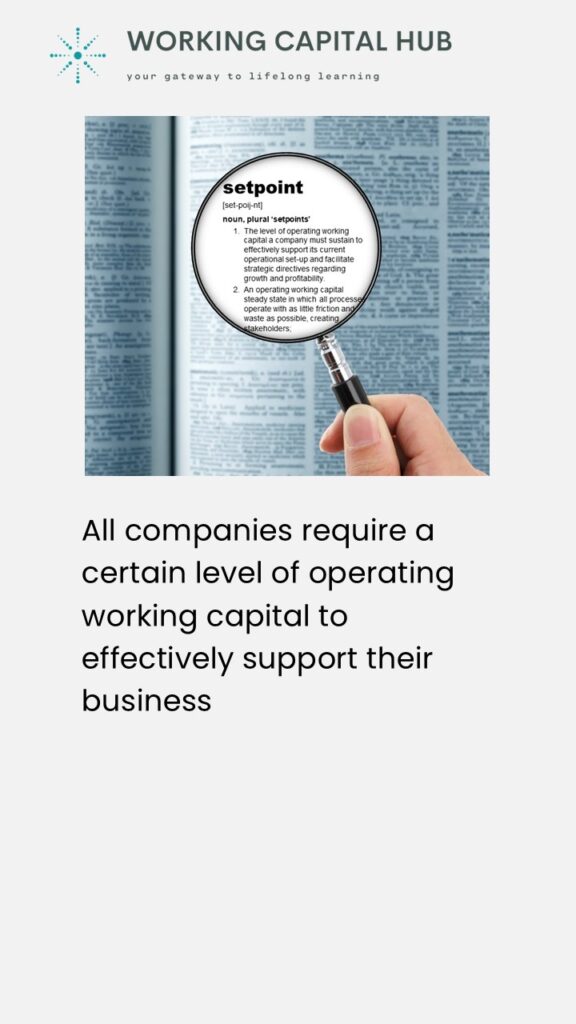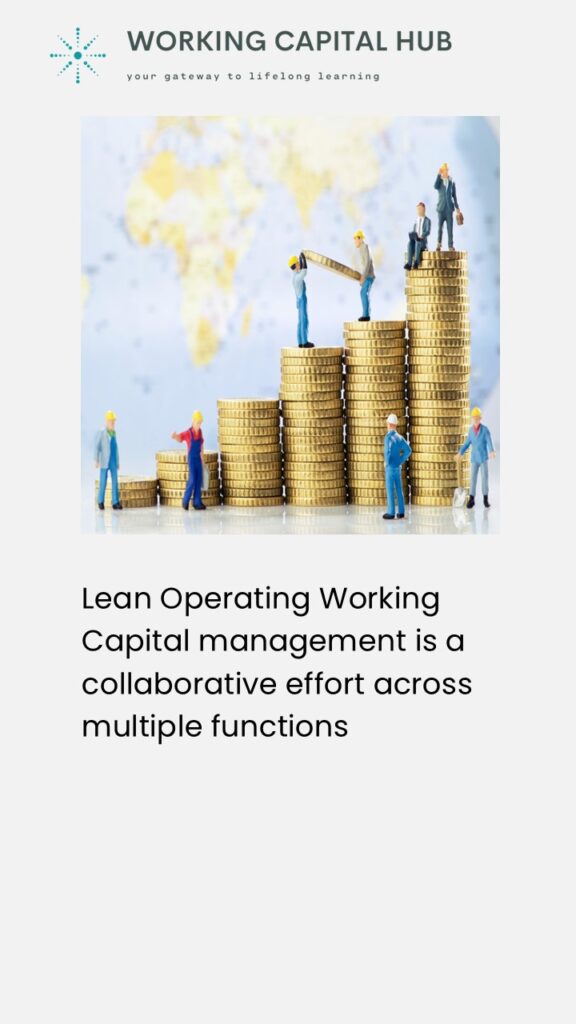
Lean Operating Working Capital – an Introduction
This article will introduce the concept of Lean Operating Working Capital and its associated Setpoint philosophy.
It will explain its origin, what it is, why it is important and its benefits. It will also briefly talk about why it is not only a finance concern, but must be managed across multiple functions.
Key Take Aways
- Lean Operating Working Capital (LOWC) empowers companies to achieve long-term growth, profitability, and resilience by balancing cashflow, reducing waste, and fostering efficient processes across departments.
- Effective LOWC practices help enhance liquidity, freeing up cash that can be reinvested into the business, reducing debt, or supporting growth initiatives.
- It is not an either-or scenario. Properly applied, LOWC boosts the Cash Conversion Cycle as well as a company’s growth and profitability.
- Rather than reducing operating working capital aimlessly, LOWC aims for an optimal balance that supports business needs without excess or shortage, known as the Operating Working Capital Setpoint.
- The Operating Working Capital Setpoint also serves as an efficient diagnostics tool, helping to uncover underlying inefficiencies in an organization’s supply chain processes.
- Also, unlike large restructuring initiatives, LOWC optimization projects integrate seamlessly into existing workflows, providing strategic benefits with minimal operational disruption.

What is the Origin of Lean Operating Working Capital?
The concept of Lean Operating Working Capital and its associated Setpoint philosophy revolves around addressing five common misconceptions that often plague Operating Working Capital management:
- It is always a choice between Operating Working Capital and profitability.
There’s a prevailing belief that organizations must prioritize one or the other. Lean Operating Working Capital positively influences profitability by optimizing cash flow, reducing costs, and improving operational efficiency. - Less Operating Working Capital is always better.
The idea that success means simply reducing Operating Working Capital (OWC) overlooks the need for balance. Each organization requires an optimal OWC level to support its business without compromising long-term performance. - Operating Working Capital projects are always triggered by an event.
OWC projects are often reactive, triggered by events like debt repayment. However, a proactive approach builds resilience and efficiency, helping to handle unexpected challenges before they arise. - It revolves around isolated process management.
OWC processes are interconnected and treating them as isolated functions can cause issues elsewhere in the organization. A holistic, cross-functional approach ensures that improvements in one area don’t create problems in others. This help avoid a “whack-a-mole” effect where solving one issue leads to new ones. - It is a finance-only concern.
The misconception that managing OWC is solely the responsibility of the finance team overlooks the significant role of operations. Operations heavily influence the Cash Conversion Cycle, and their involvement is crucial for effective OWC management.
By understanding these misconceptions and adopting a holistic, customer-focused approach, organizations can effectively balance supply chain risks and rewards while optimizing its cash conversion cycle.
This Is the core of Lean Operating Working Capital.
Learn more about the importance of managing working capital – take our accredited e-learning course Managing Working Capital on MyAcademyHub.com!
What is Lean Operating Working Capital?
The concept of Lean Operating Working Capital aims at reducing or eliminating waste of resources, such as time, money and materials.
This notion of waste was already recognized as part of the original Lean Manufacturing philosophy, described by Taiichi Ohno in his seven types of waste model.
These wastes, typically referred to as “muda” in Japanese, include among others overproduction (producing more than is needed or producing too soon) and inventory (keeping excess materials and products not being processed or sold in a timely manner).
Ohno recognized that while large volume purchases and increased production batches might appear to increase productivity on paper, there is no true cost coverage unless there is an immediate demand.
Instead, it would lead to the creation of idle assets, tying up resources that could be better used elsewhere. reducing financial flexibility and potentially missing opportunities for growth or investment.
By right-sizing inventories as well as streamlining receivables and payables processes, a Lean Operating Working Capital approach will help companies optimize their cash conversion cycles, increase topline and improve profitability.
This will in turn free up cash that can be reinvested into the company, finance growth opportunities, or used to reduce debt or pay dividends.
Note however, Lean Operating Working Capital is not about wildly cutting inventories or running the business on a shoestring. It is about understanding the circumstances of a business. Making sure you are not under- or over-serving customers, tailoring operations to strike a balance between service and cost.
The winner is not necessarily the one with the least operating working capital. It is the one with the right operating working capital.
We call this level a company’s Operating Working Capital Setpoint.

Why is Lean Operating Working Capital Important?
All companies require a certain level of operating working capital to effectively support their business.
This include making sure their day-to-day operations run smoothly, but also sustaining external relationships, as well as facilitating its strategic directives regarding growth and profitability.
In many ways, operating working capital reflect the DNA of a company, providing vital insights into its health, agility, and growth potential:
Excess Operating Working Capital
Too much Operating Working Capital suggests an inefficient use of a company’s resources, as idle assets cannot generate returns.
Excess levels are also strong symptoms of hidden process inefficiencies. These often result in inventory buffers, inefficient invoicing- and collection processes, as well as lax purchasing practices.
In essence, excess Operating Working Capital signals a misalignment between the company’s operational needs and its operating working capital resources. This in turn hinders its ability to capitalize on growth opportunities and maximize profitability.
Insufficient Operating Working Capital
On the other hand, too little operating working capital will create process inefficiencies. This is because the company may struggle to meet customer demand due to insufficient inventory or production capacity.
This can lead to missed sales opportunities, costly overnight shipments, delayed deliveries, and strained relationships with customers.
Moreover, too low levels of operating working capital can place a company in a state of perpetual firefighting, limiting its ability to proactively take advantage of supplier discounts or negotiate favorable terms, further exacerbating cost pressures.
In essence, operating with insufficient optimal operating working capital strains the company’s ability to operate efficiently, compete effectively, and sustain long-term growth
The Operating Working Capital Setpoint
The challenge is, of course, that to read these symptoms, one would first have to understand and gauge a company’s baseline operating working capital requirements. We call this equilibrium a company’s Operating Working Capital Setpoint.
The Operating Working Capital Setpoint serves as an insightful diagnostic tool, uncovering underlying inefficiencies in your organization’s supply chain processes.
At the same time, a company’s Setpoint denotes an operating working capital steady state. From here, all internal processes operate in harmony with suppliers and customers, providing perfect value for the end-customer with as little friction and waste as possible.
This steady state impacts not only your operating working capital performance but also top-line and profitability.

Lean Operating Working Capital Stakeholders
A significant portion of operating working capital and the cash conversion cycle is owned or influenced by operations, making it more than just a finance concern.
These processes are highly interconnected, highlighting the importance of a holistic cross-functional approach.
Key stakeholders include:
- Procurement. Procurement manages supplier relationships and negotiates favorable terms, helping to control cash outflows. By securing advantageous payment terms, they extend the payment cycle, contributing to improved working capital without risking supplier trust.
- Operations & Supply Chain. Operations play a major role in inventory and production planning, which directly impact working capital. Effective inventory management ensures stock levels align with demand, minimizing waste and supporting the cash cycle.
- Sales & Marketing. Sales influences accounts receivable and cash inflows through customer payment terms. Their collaboration with finance supports demand forecasting and cashflow optimization while maintaining competitive positioning.
- Customer Service & Account Management. These teams support collections by fostering strong customer relationships, aiding timely payments and preventing overdue accounts. They work with finance to balance customer satisfaction with cashflow needs.
- Warehouse & Distribution. Managing inventory storage and dispatch efficiently reduces stockholding costs and lead times, contributing to an optimized cash cycle and improved operational efficiency.
- IT & Data Analytics. IT provides tools to track transaction data metrics in real-time, enabling data-driven decisions. Analytics help identify inefficiencies and trends that inform inventory, purchasing, and credit policies.
- Finance Department. Traditionally leading working capital efforts, finance sets targets, monitors performance, and ensures cash flow aligns with broader financial strategies. They develop metrics and insights that guide OWC optimization and assess financial health.
- Executive Leadership. Leadership, including the CEO and CFO, set strategic working capital goals and promote collaboration across departments. Their support fosters a proactive, integrated approach to OWC.

The Benefits of Lean Operating Working Capital
The significance of Lean Operating Working Capital when boosting liquidity or improving efficiency metrics such as return on operating assets is evident.
Nonetheless, many organizations fail to recognize the considerable influence that strong Lean Operating Working Capital practices also have on other key performance indicators such as growth or profit margin.
While the direct link between operating working capital and a company’s growth and profit margin might not always be apparent, there exists a strong indirect correlation.
Companies with strong Lean Operating Working Capital practices tend to have higher profit margins, as they generally are better at:
- Strategic deployment of released cash. Optimizing operating working capital releases trapped cash. This can be strategically reinvested in growth initiatives such as acquisitions, product enhancements, and market expansions, ultimately boosting revenue and margins.
It can also be used to reduce the reliance of expensive short-term borrowing, such as overdraft-or working capital facilities, lowering interest expenses. - Improving availability and responsiveness to demand fluctuations. Optimized operating working capital plays a pivotal role in improving effectiveness and ensuring the availability of the right goods at the right time, enhancing pick rates and minimizing stockouts, thereby meeting customer demand promptly and maximizing sales opportunities.
It also enables businesses to respond nimbly to fluctuations in demand. This by facilitating agile procurement, production, and distribution processes, ensuring that products are readily available when needed. - Boosting efficiency and cost effectiveness. It is crucial to recognize that both cost improvements and sustained improvements to operating working capital practices rely heavily on similar core process enhancements.
These include activities such as optimizing the company’s resource allocation and utilization, improving availability of right goods at the right time, and the elimination of waste.
By removing biases and inefficiencies across the supply chain, whilst also streamlining operations, companies create a solid foundation for sustainable growth and enhanced profitability. - Streamlining operations and scalability. Companies with strong and mature operating working capital practices generally operate their supply chain with fewer full-time equivalent resources (FTEs).
These advanced companies also tend to operate more centralized with more modular and scalable processes, and lower transaction costs.
Operating working capital optimization offers businesses a multifaceted strategic advantage, encompassing improved availability of goods, enhanced responsiveness to demand fluctuations, and streamlined operational performance.
By optimizing operating working capital, businesses can unlock operational efficiencies. This in turn will drive strategic growth initiatives and cultivate resilience in today’s rapidly evolving marketplace.
Embracing working capital optimization as a fundamental pillar of financial management empowers businesses to thrive in an ever-changing business landscape.
Also, a key advantage of operating working capital projects is their minimal disruption to organizations. Unlike large-scale cost-out or restructuring initiatives, which can cause significant upheaval and distress, working capital optimizations are tactical in nature, seamlessly integrated into existing workflows with less disruption.
Eager to learn more? Check out our accredited e-learning course Managing Working Capital


Leave a Reply